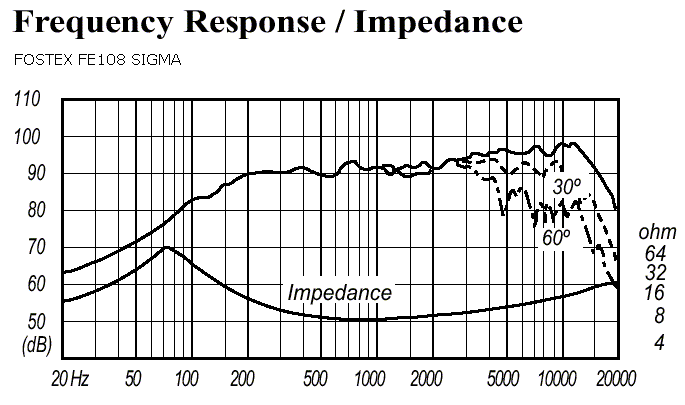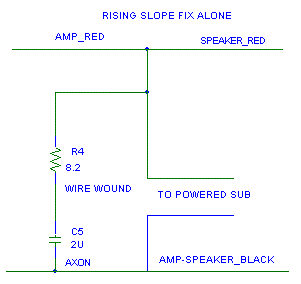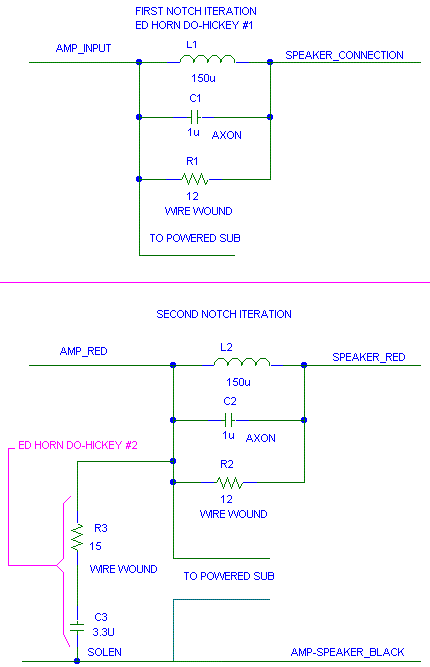
(11/21/01) (Ver 1.3) I tried putting a 20 ohm
across the 12 ohm in Do-Hickey #1. (Total R2 resistance = 7.5 ohms (I'd
just use 8 ohms))
I liked the articulation of voice better with R2 = 8 ohms instead of 12
ohms. I also have the horns firing right at the listening seat right now
and have readjusted the 1/2 wing so that there is about 1 inch more air
between the 1/2 wing and the speaker. Things keep getting better.
I put a jumper across Do-Hickey #1 to check the sound with out it. I like it better with the Do-Hickey #1 in. Some recording sound slightly better with Do-Hickey #2 out, some with Do-Hickey #2 in.
Ed's Horn sounds really good to start with and I (as always) want more. So if I point out a negative about the Horn, keep in mind that I am being picky. These Horns coupled with a powered sub have blown away many speakers. I'd have to add a zero to the price of the Horn to buy my next choice in speakers.
The Fostex driver has a peak at about 12 kHz and a rising input impedance. This means if you are driving the Horn with a SET/ Parafeed that the rising high frequency end of the horn will be accentuated. This high frequency rise adds "clarity", but to my ears makes the Horn's sound mid-bass shy. Ed does coat the cones with some magic substance that helps smooth the response, but there is still some 10-12 kHz peak left.
Below is the unmodified unmounted speaker response of the FE108S driver. Its response will be different when mounted in a cabinet.

I've tried many things to bring the mid-bass up correctly and could never get the bass right at the same time I had great image and/or midrange. (I'll get into these "issues" at a later date on this page.) After a little more pontificating, I'll give you what I did that worked well for me.
Ed flashed me an unofficial frequency response curve that was amazingly flat in the mid-bass to the upper midrange. The bass droop at 100 Hz in the Fostex graph did not exist! The back horn was reinforcing the bass just like it should. But the 12 kHz Fostex peak was still there. So it hit me, I've fallen into the trap I've pointed out to many others: The bass wasn't a bit lacking! The treble was a bit hot!
Pointer: If the bass is off, always check the treble level. If the treble is off, always check the bass level. Many ears tend to like balance.
I spent some time to come up with a small signal Pspice impedance model for the Fostex driver so I could play with a passive filter to flatten the horn response. I just modeled the raw Fostex driver based on the curves given at the Fostex site. I did not model the impedance of Ed's Horn.
After I came up with a model, I modeled and tried several filters. First I tried to flatten the rising impedance a bit so I added a Zobel across the speaker. With my 3 ohm output amps, this "rising impedance slope fix" had a nice, but small effect. I could hear it, most of my buddies could not.
DO-HICKEY
#0

So I modeled the horn for a while longer and came up with the first notch filter (DO-HICKEY #1.) When I first plugged the notch filter in, I thought the volume had been cut by 6 dB, but I was wrong. I listened for a while and thought: "This is nice." It is smooth both in frequency and presentation and the image was the best it had ever been. I had cut back on the detail just a bit and the apparent volume just a bit, but had made major gains in getting it to sound just the way I want it.
For curiosity I added the "rising slope fix" across my power amp at the same time as DO-HICKEY #1 was installed. Some things got better and some things got worse. Knowing that if some thing "wrong" in a circuit location can make the sound worse, some thing right in the same spot can sometimes make things better. So I went back to the computer and came up with a second zobel (DO-HICKEY #2) to use for impedance correction. When I added this to my set up, I thought this is better with the new zobel in than with it out.
Note: Use an air core for the inductor.

If you have an amp with a damping factor of greater than 10 at 10 kHz, you probably won't notice any change from DO-HICKEY #2. If you have a damping factor of 2 at 10 kHz, you probably will notice and improvement.
This note is important:
Now with DO-HICKEYS #1 and #2 installed I can toe the speakers in more than just a little. The sweet spot is now much larger than it was before. Also, there seems to be more high frequency information than before when the speakers were not toed in.
The zobel reduces the swing in impedance from the speaker. By reducing the swing in impedance, the speaker's sound is less sensitive to the amplifier's damping factor. If the impedance of the loud speaker was constant, amplifier damping factor would not affect the sound of the mids and highs. Of course one could design a crossover that was customized to the amplifier that was driving the speaker. This can give great performance. BUT, if you change speakers and amps often, it generates a lot of work in retuning the speaker.
How does damping factor affect the highs? "I thought damping factor only affected the bass!" With small damping factors, (high output impedance) the voltage the speaker sees is dependent on the speaker's input impedance. Unfortunately for us tube fans, most speakers are designed to be driven by a voltage source.
Why do they design speakers to be driven by a voltage source?
1. It is easier. The calculations for the crossover are simple if the crossover is driven by a voltage source.If my amp has a 3 ohm output impedance that is driving a 8 ohm speaker, there is 20 * log( 8/ (8 + 3) ) = -2.77 dB loss in the 3 ohm damping impedance from the amplifier. If the speaker's impedance were 16 ohms at high frequencies (lets assume the impedance is resistive to make the math easy), there would be 20 * log( 16/ (16 + 3) ) = -1.49 dB loss. This is a 1.28 dB increase in high frequency response. +1.28 dB is the difference between 4 watts and 5.37 watts.
2. Most people have solid state amps that sort of look like voltage sources. "Sort of" is the operational phrase here. If solid state amps were really really good voltage sources, all of us but the "equipment collectors" would be listening to them instead.
Let's take a more extreme example, a 4 ohm output impedance amp driving an 8 ohm speaker with a dip to 3 ohms due to a crossover design:
20 * log( 8/ (8 + 4) ) = -3.52 dB
20 * log( 3/ (3 + 4) ) = -7.36 dB
This is a -3.84 dB difference. Which is the
difference between 4 watts and 1.65 watts.
An LCR impedance corrector (L in series with a C in series with an R) was able to get a flatter input impedance from 1K to 12 kHz than the simple zobel. However, for kicks, I tried moving the LCR values off a bit and the impedance changes were worse than with no impedance correction. So the KISS (Keep It Simple Stupid) axiom finally showed up and started snapping at my heals.
For some time now I've played with a set of wings for the back of the Horn. I covered the wings with low pile carpet to damp the wood and to eat any upper midrange coming out of the horns. I used to have slate tile glued to the back of the wings. The wood warped and the tile fell off. (OUCH!) The wings sounded much better with the tile glued on the back. You could knock your knuckles on the wings and they were dead quiet.
You can position these wings in many ways. Movements of the position as small as an inch affects the sound. I used a 23.5 inch tall by 17.0 inch deep piece of edge laminated pine for the wings because it was pre-cut and cheaply available at Home Depot. I'm seriously thinking about building a second better set.
In the picture you can see the "rising slope fix" installed, the wings butted up against the horn and the listener (left in the image) side of the wings stuffed with pillow stuffing. The wing is not at it's best angle in the picture. That funny looking foot at the bottom had just nudged it and this was the unfortunate picture that came out the best.
iFirst edition 11/16/01, last update 11/21/01
I don't
change the update date on individual sections for minor corrections.
I only change the date for content changes.
 ( New
2024 index page.)
( New
2024 index page.)
 _( Old 2003 index page.)
_( Old 2003 index page.)
 _( AMP Second index
page.)
_( AMP Second index
page.)
 ( Fancy index page.)
( Fancy index page.)